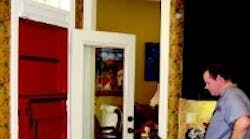AirRite energy auditor Sean Simons performs an infiltration test on a customer's home.
I'll never forget the day when I first understood just how powerful indoor air quality (IAQ) testing could be.
It was 1991, and I was running a smoke test at a customer's home with an infiltrometer. This customer had been complaining about all the dirt in his home. We maintained his equipment, and he was constantly changing his filters, but dirt and dust were still everywhere.
The test stunned us — the customer and I watched smoke pour into the eaves and into the space between the home's two stories. All that dust and bad air was being brought in by negative pressure. We got things fixed for him thanks to that test, and as a byproduct of finding the solution to the problem, we sold some equipment. I was hooked.
Today, IAQ is the fastest growing part of my business, increasing at more than 25% a year, and it has pushed our company's growth as a whole over the past few years. It's a source of success for my company and for all my customers, who are breathing cleaner, healthier air.
Mythbusting
Since I became hooked on the value of IAQ testing in 1991, I've spoken with a lot of people in our industry. What I've found out is that folks have reasons for not getting started in IAQ. I call these "myths." Here are the top six:
- My company is too small
- My customers won't buy IAQ
- IAQ products aren't really necessary
- My customers aren't really interested in IAQ
- IAQ is a fad
- IAQ is too expensive
There's one other thing that I find stops people from getting started in IAQ: our egos. Getting into IAQ takes a willingness to take on a new business model — one that isn't necessarily focused on equipment as the biggest piece of your cost ratio — and a strong commitment to training and education.
The IAQ Jump-start Formula
Everyone in the IAQ business has had to face challenges. But there are five specific steps that can be taken to overcome those challenges and develop that business:
- Make the decision: decide that you are going to be in the IAQ business.
- Build your team: determine roles and who fills them.
- Choose your tools: measurement takes the guesswork out of solving customer problems.
- Choose products: you already have the equipment, now package it.
- Gain confidence: get team buy-in; educate, train, and familiarize.
Let's take a closer look at these five, and get you on your way to IAQ success.
1. Become an IAQ business. I started out in IAQ because I saw that my customers had problems, and I wanted to do whatever I could to fix it for them. This involved taking the time to really learn what was going on and what — and who — was out there that could help. I hear that same kind of dedication to customers from just about everyone I talk to.
After that eye-opening day when I saw how testing the home solved a mystery for one of my customers, IAQ was a nobrainer. It was obvious to me that there had to be other folks out there with similar problems who could use our help. To this day it remains clear to me that the IAQ business is the future of a healthy HVAC industry, as well as healthy family, neighbors, and friends.
Quite simply, doing right by our customers is good business. Frank Snyder, general manager at Alamo Cool Air, San Antonio, TX, sums it up very well: "What got us into IAQ was our interest in learning how to better serve our customers. We're not going in just trying to sell equipment. We approach our customers with effective questioning and really take our time. We listen to what they're telling us because that lets us do our job and help them based on their actual needs."
Along with doing what's right for your customers, do what's right for your business, too. The other crucial aspect in becoming an IAQ business is to set goals. Ask yourself what you want this new segment of your business to achieve. How do you want your business to change? Set concrete goals you can analyze and measure.
2. Build your team. When I started developing AirRite's IAQ business, I took on the role of IAQ champion. I personally did the testing and selling. I also made sure that I shared what I knew with everyone who worked with me.
Now, with business booming thanks to IAQ, and with 45 employees versus the 10 I started with, I have four comfort consultants and one full-time IAQ tester. Everybody here has been trained in IAQ basics. It's important that everyone from the dispatcher on up have the ability to talk IAQ basics, and understand how it connects to what we do for our customers.
The key is to have someone at the company who spearheads IAQ business development.
Alexander Lyman is the indoor air quality specialist at Aire Serv of Comfort Zone, Arcola, VA. Three and a half years ago, when the company decided to move into IAQ, Alex was tapped to develop that segment of the business. He has some good advice for anyone getting started in IAQ.
"The first challenge you're going to face trying to grow a division from scratch is to dedicate the time to it," Alex says. "But absolutely, if you want to succeed, it must be done, and you can't slack off on it.
"I can't say it strongly enough: name someone to do the research. That person can then lead the way and gain the insight to start dealing with the next set of challenges. Naming someone to be responsible is the first step to making that paradigm shift to getting started in IAQ. It can be a lot to commit to up front, but it's the way to make it happen."
One last word about building your team: incentives. Reward your employees for taking on growth and change by building incentives into actions and successes related to your IAQ goals.
3. Choose your tools. When it comes to IAQ, you need the right set of tools to diagnose what's going on in your customers' homes or business. We already test and measure other HVAC issues and problems, but with IAQ it's especially important because what we're doing is making the invisible, visible. My mantra is test, test, test and analyze, analyze, analyze — and then make your recommendations.
Learn about your options. Talk to other contractors or your manufacturer's territory managers. Attend IAQ training events or trade show presentations. Read up on what's out there; get the whole picture, not just part of a picture.
Whatever tools you choose, make sure that you're going in testing, not guessing.
"Each time one of our comfort advisors places an IAQ test and presents the report to a customer, he becomes more convinced about just how powerful this is," says Jamie Henderson, general manager, Neal Air Conditioning, Corpus Christi, TX. "He's really motivated by the fact that he can see what's going on and make a solid recommendation, and that motivation spills over into his presentation to the customer. Total sale per call is up and our customers are reassured."
William Ziebell, home comfort consultant at Metal Masters in Medford, OR, shares that view. He's seen sales growth at his rural-and suburban-based business quadruple since the company went into IAQ.
"Having a really good diagnostic program gives us credibility," Ziebell says. "It allows people to see what's in their air. And it's great to do the 'before' and 'after' test to show our customers that what we've done is really working for them. It reassures them and it separates us from the rest. We get a lot of referrals and service contracts that way."
4. Choose your products. The next step is to choose the products you'll offer as solutions to various IAQ problems.
Understanding your equipment is a vital part of IAQ. Take advantage of any training offered by manufacturers. Look for ongoing support, and a commitment to solid IAQ solutions.
In our industry, we have a commitment to our customers to not allow them to breathe bad air. Knowing our equipment — and when to recommend it — lets us fulfill that commitment.
"With IAQ it's vital that you do your homework and understand the difference between the products out there and how best to help your customer depending on their situation," Lyman says. "You need to know it from several perspectives — the health perspective, which products are the easiest to install, what the maintenance issues are, and which ones are most cost-effective from both the business and customer service standpoints."
5. Gain confidence, educate, and train. This should go without saying but I'm going to say it anyway: don't underestimate the importance of this step.
If you want to get started in IAQ, you must give yourself and your team the confidence and the know-how to get in front of your customers. You can have the most whiz-bang tools and products available on earth, but if you or your team isn't sure about the why and how, they'll sit on the shelf — and that won't help a single customer, or make you a single dime.
There are many solid IAQ training and certification resources: national indoor air quality or environmental agencies, HVACIAQ manufacturers, and programs at regional and national HVAC conventions, to name a few. My team and I take advantage of as many of these as possible.
Robert Freeman, president and sales manager, Fenix Heating and Cooling, Wichita, KS, is a firm believer in ongoing IAQ training.
"When we started IAQ two and a half years ago, we didn't have an IAQ champion," Freeman says. "We had to develop one. We attended training sessions and began to develop a methodology out of that training. Without the training, you limit yourself in your ability to take IAQ out to your customer."
Freeman is straightforward about the commitment that's necessary to getting started in IAQ.
"I tell people from my own experience that when it comes to IAQ, you must fully stick with it," Freeman says. "You must believe in it and get out there with it — spend the money and, especially, spend the time to do it right."
Robert's experience echoes what Joe Henry taught me all those years ago. Putting aside our egos and saying we don't know allows us to go out and get whatever new information is out there for us. That way you don't go out there doing today's business with yesterday's ideas. That will put you out of business tomorrow.
Getting There From Here
No one article can cover every situation for every contractor. But based on many conversations and plenty of hands-on experience, you will find yourself on your way to building a healthy IAQ business by following the five steps outlined above.
Here's wishing you good business and clean, healthy air for your customers.









